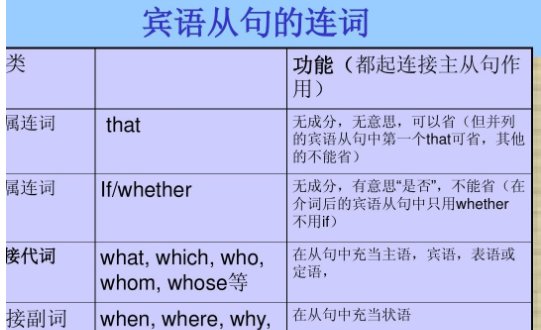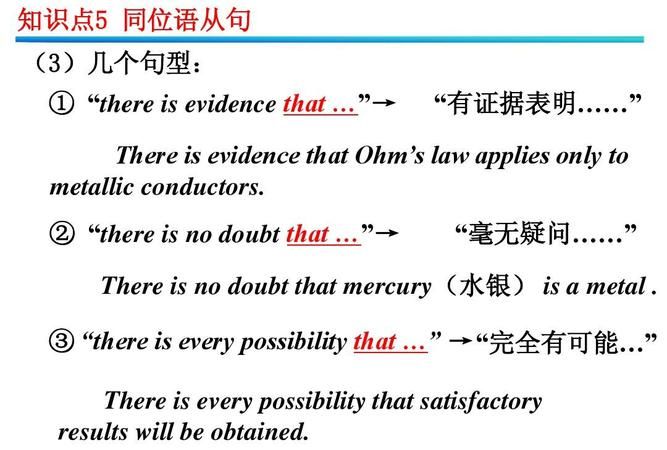本文目录
高中英语同位语的知识点
一个名词(或 其它 形式)对另一个名词或代词进行解释或补充说明,这个名词(或其它形式)就是同位语。同位语与被它限定的词的格式要一致,并常常紧挨在一起。下面我给大家分享一些高中英语同位语的知识,希望能够帮助大家,欢迎阅读!
高中英语同位语的知识1
用法
一个名词(或其它形式)对另一个名词或代词进行修饰,限定或说明,这个名词(或其它形式)就是同位语。同位语与被它限定的词的格式要一致,并常常紧挨在一起。同位语从句即重复说明同一个称谓或事件的从句。
1、名词作同位语
Mr Wang, my child’s teacher,will be visiting us on Tuesday.
王先生,我孩子的老师,星期二要来看我们。
(在这里'my child's teacher'做同位语修饰'Mr Wang')
2、 短语 作同位语
I, the oldest girl in the family, always had to care for the other children.
我,作为家里最大的女孩,总是要照料家中的其他孩子。
3、直接引语作同位语
But now the question comes to their minds,“Did she die young because she was a clone?”
但是现在他们不得不思考这样的问题:“多莉早死是因为它是一只克隆羊吗?”
4、 句子 作同位语
The girls were surprised at the fact that ocean ships can sail up the Great lakes.
巨大的海轮可以开到五大湖,让表姐妹俩感到吃惊。
高中英语同位语的知识2
固定用法
同位语部分是个句子,就是同位语从句,这种用法比较"固定"。
1、在复合句中用作同位语的从句叫同位语从句。它一般跟在某些名词后面,用以说明该名词表示的具体内容。
I heard the news that our team had won.
我听到了我们队获胜的消息。
2、可以跟同位语从句的名词通常有news,idea,fact,promise,question,doubt,thought,hope,message,suggestion,words(消息),possibility,decision等(一般的“抽象”名词都可用)。
I’ve come from Mr wang with a message that he won’t be able to see you this afternoon.
我从王先生那里来,他让我告诉你他今天下午不能来看你了。
3、英语中引导同位语从句的词通常有连词that,whether,连接代词what,who。连接副词how,when,where等。(注:if不能引导同位语从句。)
He must answer the question whether he agrees with it or not.
他必须回答他是否同意这样一个问题。
4、有时同位语从句可以不紧跟在说明的名词后面,而被别的词隔开。
The thought came to him that maybe the enemy had fled the city.
他突然想起敌人可能已经逃出城了。
高中英语同位语的知识3
引导词
同位语从句的引导词,引导同位语从句的词语通常有连词that,whether,连接代词和连接副词等。
1、that引导
that连接从句时从句为一个句意完整的陈述句。that不能省略,没有具体的意思,不充当句子成分,只起连接作用。
(注:引导同位语从句的that不能省略)
The idea that you can do this work well without thinking is quite wrong.
你认为不动脑筋就能做好这件工作的想法是完全错误的。(作idea的同位语)
【注意1】在某些名词(如demand, wish, suggestion, resolution等)后面的同位语从句要用虚拟语气
There was a suggestion that Brown should be dropped from the team.
有一项建议是布朗应该离队。
【注意2】引导同位语从句的连词that通常不省略,但在非正式文体中也可以省去。
He grabbed his suitcase and gave the impression he was boarding the Tokyo plane.
他拿起了手提箱,给人的印象是他要登上飞往东京的飞机了。
2、whether引导
(注:if不能引导同位语从句)
The question whether we should call in a specialist was answered by the family doctor.
我们是否请专家由家庭医生来定。
【注意】whether 可引导同位语从句,但if不能引导同位语从句。
3、连接代词what,who,whom,whose引导
1).I have no idea what size shoes she wears.
我不知道她穿几号的鞋。(what作定语)
2).The question who will take his place is still not clear. (who作主语)
4、连接副词when,where,how,why引导
We haven’t yet settled the question where we are going to spend our summer vacation.
到哪儿去度暑假,这个问题我们还没有决定。
高中英语同位语的知识点相关 文章 :
★ 高中英语知识点
★ 高中英语的知识点归纳
★ 高中英语语法知识点整理总结
★ 高中英语语法的知识点
★ 高中英语语法知识点
★ 高三英语语法知识点
★ 高中英语语法知识点
★ 高中英语语法知识点整理
★ 2017年高中英语知识点
★ 高中英语高考知识点

宾语从句笔记整理初中
四种非谓语动词:动词不定式、动名词、现在分词、过去分词。
五种简单句:主语+谓语;主语+谓语+宾语;主语+谓语+双宾语;主语+谓语+宾语+宾补;
主语+系动词+表语。
六种复合句:定语从句、状语从句、四种名词性从句
(主语从句、宾语从句、表语从句、同位语从句)
强调句、倒装、省略、虚拟语气、情态动词、冠词、形容词和副词、连词、介词。
以上就把语法概括差不多了。另外再自己整理一下做题遇到的短语、句型和生词等就完美了。你根据我列出来的知识要点分类整理一下笔记,一般来讲收集整理80道单选题以后,笔记就应该有一定规模了,就是说重复内容就出现了,把同一类型的考题放在一起观察异同点,必有所获。

特点
宾语从句可以作及物动词、介词及形容词的宾语。
宾语从句的语序一律用陈述句语序。
连接词that引导宾语从句在句中无词义,不充当句子成分,口语中一般可以省略。
whether 和 if 都可引导宾语从句,但 whether后可紧跟or not;whether从句可作介词的宾语。当if/whether引导宾语从句时,在从句中不做任何成分,但有具体的含义,意为“是否”。if/whether不能省略。
如果从句太长,可以用形式宾语it。
英语名词性从句课件
我们在上一期中说过,根据 在句中不同的语法功能 ,名词性从句可以分为 主语从句、宾语从句、表语从句和同位语从句 。根据名词性从句的构成可以分为: that从句,whether 从句和疑问词引导的从句 。但我们要特别注意以下几点:
1、that从句不可做介词的宾语,只能用whether 从句或疑问词引导的从句。
例1. I am worried about whether he can do it .
那如果硬要用that从句怎么办呢?且请看
① 在介词之后加the fact ,结构为: 介词+ the fact+ that从句
I am worried about the fact that he doesn’t study.
② 不加 the fact ,对that从句进行如下变化:去掉that,之后的主语变成所有格,动词变成动名词。
例:I am worried about the fact that he plays around all day →
I am worried about his playing around all day.
注意:
A. 若that从句有助动词do、does、did、will和would时,直接去掉
例. I am worried about the fact that he doesn’t study. →
I am worried about his not studying.
B.
若有may 和can助动词时。May变成be likely to;can变为 be able to。
例. I am happy about the fact that he may come
I am happy ab
out his being likely to come
③ 直接去掉介词。 形成 be + adj.+ that从句.
例. I am worried that he plays around allday.
三个大招,大家都理解了吗?
特例:
In that =because 因为
例. He is talented in that he can speak five different languages.
Exceptthat 只可惜,除了
例. He is nice except that sometimes helies.
2、同位语从句和定语从句要分清楚。
前面我们提到了,名词性从句包括 同位语从句 ,定义:在复合句中充当同位语的名词性从句称为同位语从句。但是很多同学却容易把 同位语从句和定语从句 搞混了,我查阅了很多区分的方法,总结了一下,发现下面两种最适用。
大家能区分这两个句子哪个是同位语吗?
1.The news that he will come back is true.
2.The news that he told me is true.
区分方法一:
同位语从句中 从句是对被修饰词进行补充说明,是被修饰词的具体内容。 定语从句中 从句是起限定作用,不是被修饰词的具体内容。
两句中的被修饰的词都是news,但是第一句中的从句that he will come back是news的具体内容(补充说明:消息是他将会回来);而第二句that he told me就不是news的具体内容了,而是限定他告诉我的消息。
另外,可以跟同位语从句的名词通常有 news,idea,fact,promise,question,doubt,thought,hope,message,suggestion,words(消息),possibility等抽象名词。
具体区别如下:
区分方法二
如果上面通过上面还区分不出来, 把被修饰的词和从句用be动词连成一句话,句子成立的就是同位语从句,不完整的是定语从句.这个方法大部分句子都适用。
比如,第一句就是 the news is that he will come back(消息是他将会回来)句子完整.第二句是 the news is that he told me(消息是他告诉我,告诉什么却没有说)句子不完整.所以第一句是同位语从句,第二句是定语从句了。
总结:到这一期可做名词的词类就讲完了,总共有7类,分别是: 名词、代词、动名词、动词不定式、名词性从句、名词短语以及表距离的地点副词短语 都可以做主语。大家都记住理解了吗?
欢迎大家留言讨论,下期再见

高三英语知识点总结归纳
高二英语 在整个高中英语中占有非常重要的地位,既是高二又是整个高中阶段的重难点,所以要保持良好的学习心态和正确的 学习 方法 。下面就是我给大家带来的 高三英语 语法知识点,希望对大家有所帮助!
高三英语语法知识点1
一、不定式做主语:
1、不定式做主语一般表示具体的某次动作。===动名词doing 表示习惯的,经常的动作。
e.g: To finish the building in a month is difficult.
To do such things is foolish.
To see is to believe. (对等)
注: 1). 不定式作主语时,谓语用单数
2). 当主语较长,谓语较短时,常用it做形式主语,而将不定式放到谓语的后面。
it做形式主语,不定式放在谓语动词之后常用于下列结构中:
(1)It is/was +adj.+of sb. to do…
(2) It is +adj.+for sb.+to do…
It is easy / difficult / hard / foolish / unwise / right / wrong / unnecessary
(3) it is +a +名词+ to do...
It is a pity / a pleasure / a pleasant thing / one’s duty / an honor / a shame / a crime / no easy job… to do
It takes (sb.) some time / courage / patience …to do…
It requires courage / patience / hard work… to do…
注意: probable 和 possible 均可作表语,但possible可以用不定式作真实主语, 而probable不能用不定式作真实主语。
It is probable for him to come to the meeting.(错)
It is possible for him to come to the meeting.
It is possible / probable that he will come to the meeting.
高三英语语法知识点2
一、非谓语动词
“非谓语动词”可分为动词不定式、动名词和分词.它在 句子 中的作用很多:除了不作谓语外,它可以充当主语、宾语、表语、定语、状语与复合宾语(主语补语或宾语补语).有些及物动词后面接不带to的不定式作复合宾语.这些动词归纳如下:一感(feel).二听(hear,listen to),三让(have,1et, make),四看(see,watCh,notice,observe).再加上help somebody(to)do something和美国英语look at somebody do somthing.还有“二让”属特殊:get somebody to do something 与keep somebody doing.而有些及物动词后面接动名词(the -ing form)作宾语.这些动词归纳为一句话:Papa C makes friends.这是由如下动词的开头字母组成:permit,advise, practise,avoid,consider,mind, allow,keep,enjoy,suggest, finish,risk,imagine,escape,need,delay,stand(忍受). 为了容易记住,也可以编成 顺口溜 :“允许完成练习,建议避免冒险,考虑延期逃跑,喜欢保持想象,需要反对忍受”.其相对应的动词依次是:permit/allow,finish,practise;
advise/suggest, avoid,risk: consider, delay, escape/miss; enjoy/appreciate, keep, imagine; need/want/require,mind. can't help/can’t stand.
二、复合句
1、学生最容易混淆的是定语从句与同位语从句的区别.
例如:A、The news that our team has won the match is true. (同位语从句)
B、The news that he told us surprised everybody here. (定语从句)
关键的区别在于连接或关系代词that:有意义的是定语, 无意义的是同位.因为引导定语从句的that在从句中作主语或 宾语,而引导同位语从句的that只起到连接词的作用.
2、接着容易混淆的是引导定语从句的关系代词that与 which:that之前是不定(代词)、序数(词)、(形容词)级:which之前是介词 短语 与逗号(非限制性).
例如:A、All that we have to do is to practise every day.
B、The first lesson that I learned will never be forgotten.
C、I have lost my pen,which I like very much.
D、The house in front of which there is a garden is my home.
三、It的用法
1、It除了代替人和物以外,还可以作形式主语.而真正的主语(不定式、动名词或从句)则放于谓语或表语之后.
例如:It is nor easy to finish the work in two days.
然而有少数表语之后接动名词作真正的主语.这些表语是:无助(no help)、无用(no use)、没好处(no good);工作(hard work)、费时(a waste of time)、又危险(a danger).
例如:A、It is no use crying over spilt milk.
B、It is a waste of time waiting for him.
2、It还可以作形式宾语.通常下列动词后面可接it作形式宾语:2f2tcjm(find,feel,think,take,consider,judge, make).
例如:A、He made it clear that he was not interested in this subject.
B、I think it no use arguing with him.
3、It用于强调句式.要强调句子的某一部分(主语、宾语、 状语),可以把it当作先行词.这种句子的结构是:It is(was)+ 被强调部分+that(who)+句子的其余部分.
例如:A、It iS Professor Lin who teaches us English—(强调主语)
B、It was in Shanghai that l saw the film.—(强调状语)
C、It was in 1990 that I worked in the factory.(同上)
但要注意与定语从句的区别.
例如:D、It was 1990 when I worked in the factory.(定语从句)
在强调句式里,我们把强调结构It is(was)…that除去,句子还很完整.如例句C.而例句D就不能.
四、倒装结构
学生容易混淆的是全部倒装与部分倒装.如何区分之,编个顺口溜:副(adv.)介(prep.)提前全倒装, 其它 句式部分倒;否定提前倒助动,让步状语倒表语;复合句式倒主句,不
倒装的属特殊.下面举例说明:
A、Here comes the bus.(副词提前,全倒装)
B、Here he comes.(代词作主语,不倒装)
C、In front of the house lies a garden.(介词短语提前,全倒装)
D、Never shall I do this again.(否定词提前,部分倒装)
E、Young as he is ,he knows a lot.(让步状语从句,表语倒装)
F、Only when he told me did I realize what trouble he was in.(only 修饰状语,主句倒装)
G、Only he can save the patient.(only修饰主语.不倒装)
H、Not only will help be given to people,but also medical treatment will be provided.(否定词提前,部分倒装)
I、Not only he but also we like sports.(连接两个主语,不倒装)
五、虚拟语气
虚拟语气也是一个难点.所谓虚拟语气是表示说话人的愿望、假设、猜测或建议,而不表示客观存在的事实.它通过句子的谓语动词的特殊形式来表示.现归纳如下:纯假设,用虚拟,动词时态退一级:条件句,分主从,主句谓语前加would (should,could,might);表愿望,用虚拟,wish后面接宾语(从句):现在过去与将来,动词时态退一级:提建议,用虚拟,宾语(从句)动词用(should)do:俩建议,三要求,再加坚持与命令(suggest,advise,demand,require,request,insist,order):It is time和eoukd rather,后接丛句用虚拟:部分主语从句中, 谓语用虚拟结构 (It is necessry /important/natural/natural/strange/strange that……should do). 下面举例说明:
A、If you came tomorrow,we would have the metting. (条件句虚拟)
B、Without air,there would be no living things.(同上)
C、We wish we had arrived there two hours earlier.(表示愿望虚拟)
D、He demanded that we (should)start right away.(表示建议虚拟)
E、It is(high)time that we left (should leave)now.(特殊从句虚拟)
F、I would rather you gave me the book.(同上)
G、It is necessary that we should clean the room everyday,(主语从句虚拟)
H、He speaks English so fluently as if he were English. (特殊从句虚拟)
高三英语语法知识点3
宾语从句就是在复合句中作宾语的名词性从句,通常放在主句谓语动词 (及物动词) 或介词之后。
1. 作动词的宾语
(1) 由that引导的宾语从句(that 通常可以省略), 例如:
I heard that be joined the army. 我听说他参军了。
(2) 由what, whether (if) 引导的宾语从句,例如:
a) She did not know what had happened. 她不知道发生了什么。
b) I wonder whether you can change this note for me. 我想知道你是否能帮我改一下笔记。
(3) 动词+间接宾语+宾语从句。例如:
She told me that she would accept my invitation. 她对我说她会接受我的邀请。
2. 作介词的宾语,例如:
Our success depends upon how well we can cooperate with one another. 我们的成功取决于我们之间的合作。
3. 作形容词的宾语,例如:
I am afraid (that) I've made a mistake. 我恐怕我已经犯了一个错误。
注意:that 引导的从句常跟在下列形容词后作宾语:anxious, aware, certain, confident, convinced, determined, glad, proud, surprised, worried, sorry, thankful, ashamed, disappointed, annoyed, pleased, hurt, satisfied, content 等。也可以将此类词后的that 从句的看作原因状语从句。
4. it 可以作为形式宾语
it 不仅可以作为形式主语,还可以作为形式宾语而真正的宾语that 从句则放在句尾,特别是在带复合宾语的句子中。 例如:
We heard it that she would get married next month. 我听说她下个朋就会结婚了。
5. 后边不能直接跟that 从句的动词
这类动词有allow, refuse, let, like, cause, force, admire, condemn, celebrate, dislike, love, help, take, forgive等。这类词后可以用不定式或动名词作宾语,但不可以用that引导的宾语从句。如:
正确表达:I admire their winning the match.
错误表达:I admire that they won the match.
6. 不可用that从句作直接宾语的动词
有些动词不可用于“动词+间接宾语+that从句”结构中,常见的有envy, order, accuse, refuse, impress, forgive, blame, denounce, advise, congratulate等。例如:
正确表达:He impressed the manager as an honest man.
错误表达:He impressed the manager that he was an honest man.
7. 否定的转移
若主句谓语动词为think, consider, suppose, believe, expect, fancy, guess, imagine等,其后的宾语从句若含有否定意义,一般要把否定词转移到主句谓语上,从句谓语用肯定式。例如:
I don't think this dress fits you well. 我认为这件衣服不适合你穿。
表语从句
表语从句在复合句中作表语的名词性从句,放在系动词之后,一般结构是“主语+连系动词+表语从句”。可以接表语从句的连系动词有be, look, remain, seem等。引导表语从句的that常可省略。另外,常用的还有the reason is that… 和It is because 等结构。例如:
1) The question is whether we can make good preparation in such a short time.
2) This is why we can't get the support of the people.
3) But the fact remains that we are behind the other classes.
4) The reason he is late for school is that he missed the early bus.
同位语从句
同位语从句就是在复合句中作名词的同位语的名词性从句。
1. 同位语从句的功能
同位语从句对于名词进一步解释,说明名词的具体内容,一般由that引导,例如:
1) The king's decision that the prisoner would be set free surprised all the people.
2) The order that all the soldiers should stay still is given by the general.
2. 同位语在句子中的位置
同位语从句有时可以不紧跟在它所说明的名词后面,而是被别的词隔开。例如:
He got the news from Mary that the sports meeting was put off.
3. 同位语从句与定语从句的区别
(1) 定语从句中的that既代替先行词,同时以在从句中作某个成分(主语或宾语),而同位语从句中的that是连词,只起连接主句与从句的作用,不充当句中任何成分。
(2) 定语从句是形容词性的,其功能是修饰先行词,对先行词加以限定,描述定的性质或特征;同位语从句是名词性的,其功能是对名词进行补充说明。例如:
1) The news that he told me is that Tom would go abroad next year.(他告诉我的消息是汤姆明年将 出国 。)(第一个that引导的从句是定语从句,that在从句中作宾语)
2)The news that Tom would go abroad is told by him.(汤姆将出国的消息是他讲的。)(同位语从句,that在句中不作任何成分)
高三英语语法知识点相关 文章 :
★ 高三英语语法知识点归纳汇总
★ 高三英语语法知识点
★ 高三英语语法知识点小结
★ 高三英语语法知识点高效总结
★ 高考英语语法知识点
★ 高考英语语法知识点
★ 高中英语语法知识点整理总结
★ 高考英语语法与知识点整理
★ 高考英语必考语法知识点
var _hmt = _hmt || []; (function() { var hm = document.createElement("script"); hm.src = "***/hm.js?3b57837d30f874be5607a657c671896b"; var s = document.getElementsByTagName("script")[0]; s.parentNode.insertBefore(hm, s); })();
以上就是关于同位语从句笔记整理 ,定语从句 宾语从句 主语从句 状语从句 表语从句 同位语从句的区别的全部内容,以及同位语从句笔记整理 的相关内容,希望能够帮到您。

